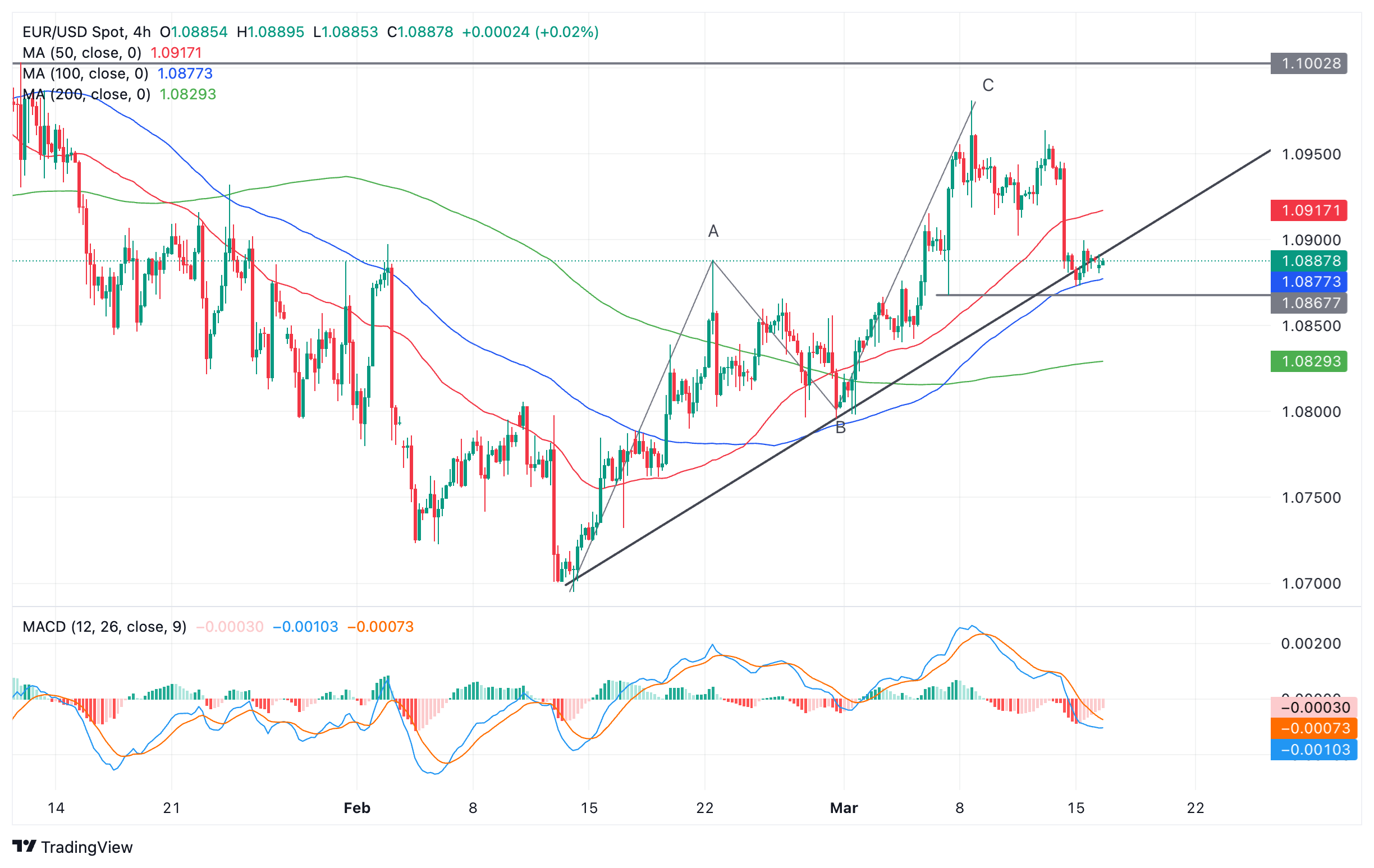- EUR/USD is under pressure as expectations of the Fed cutting interest rates sooner than expected fade.
- The dot plot from Wednesday's Fed meeting could show a shift from three to two cuts this year, Bloomberg reports.
- Such a change would likely cause more negativity for EUR/USD.
EUR/USD has taken a step back and is now trading within a new range in the 1.0800 area following last week's warmer-than-expected US inflation data, which increased the likelihood that the Federal Reserve (Fed) may have to keep interest rates higher for longer.
Since higher interest rates attract more foreign capital inflows, this was positive for the US dollar (USD), but negative for EUR/USD, which measures the purchasing power of one euro (EUR) in USD terms.
EUR/USD prepares for Wednesday's Fed meeting
EUR/USD is likely to see further volatility on Wednesday, when the Fed concludes its March meeting, announces its policy decision and releases its Summary of Economic Projections (SEP). It is highly unlikely that the Fed will announce a rate cut at the meeting, even though it was a possibility a few weeks ago.
“The reality is that the Fed is going to take its time,” said Mark Cranfield, an analyst at Bloomberg MLIV.
His view is supported by CME's FedWatch tool, which calculates the market-based probabilities of the Fed cutting rates. At the time of this report, the probability of the Fed making one or more 0.25% cuts in June was 58%, and 76.5% in July. This percentage has fallen from the 80% recorded by the tool at the beginning of the month.
In the last SEP, the Fed's board of governors predicted at least three 0.25% interest rate cuts in 2024 in its “dot plot”, however Bloomberg News claims there is now a material possibility that this be reduced to just two cuts after the March meeting. According to Cranfield, this reduction would be considered “quite aggressive.” Therefore, EUR/USD is likely to weaken further.
“A pleasant surprise would be if the Fed maintained three cuts,” added Cranfield, suggesting that such a maintenance of the status quo would be bearish for the USD (bullish for EUR/USD).
July, the new June
A report published by Bloomberg on Monday shows that after digesting more than 900 headlines citing Fed officials since the beginning of the year, the conclusion is that July is actually more likely to be the month in which the Fed begins to ease its monetary policy, instead of June.
If this is so, market expectations will have to move further away from June, with negative consequences for EUR/USD, all things being equal.
Little important data will be released in the Eurozone on Monday. The Consumer Price Index data for February is a revision of an estimate and is unlikely to deviate from the preliminary result of 2.6% for the general index and 3.1% for the core.
Technical Analysis: EUR/USD Looms Over the Abyss
EUR/USD finds temporary support as it extends its correction from the March 8 high at 1.0981.
The depth of the correction calls into question the sustainability of the dominant short-term uptrend so far.

Euro vs US Dollar: 4-hour chart
Prices remain above the fundamental level of 1.0867, the previous swing low. This level is likely to be decisive for the trend. If prices were to settle below, the balance of probabilities would tilt in favor of a reversal of the uptrend.
Such a breakout would likely extend to 1.0795, the low of the B leg of the previous ABC pattern of measured movement that developed to the upside during February and early March.
Alternatively, if the level holds, the short-term uptrend remains intact and is likely to resume. Confirmation of a higher high and an extension of the uptrend would come from a break above the 1.0981 highs.
After that, stiff resistance is expected at the psychological level of 1.1000, a likely bloody battlefield for bulls and bears.
However, a decisive break above 1.1000 would open the doors for further rises towards the key resistance level of 1.1139, the December 2023 high.
A “decisive” breakout is characterized by a long green candle breaking cleanly above the level and closing near its high, or three green bars in a row, breaking cleanly above the level.
Frequently asked questions about the Fed
What does the Federal Reserve do and how does it affect the dollar?
The monetary policy of the United States is directed by the Federal Reserve (Fed). The Fed has two mandates: achieving price stability and promoting full employment. Your main tool to achieve these objectives is to adjust interest rates.
When prices rise too quickly and inflation exceeds the 2% target set by the Federal Reserve, it raises interest rates, increasing borrowing costs throughout the economy. This translates into a strengthening of the United States Dollar (USD), as it makes the United States a more attractive place for international investors to place their money.
When inflation falls below 2% or the unemployment rate is too high, the Federal Reserve can lower interest rates to encourage borrowing, which weighs on the greenback.
How often does the Federal Reserve hold monetary policy meetings?
The Federal Reserve (Fed) holds eight meetings a year, in which the Federal Open Market Committee (FOMC) evaluates the economic situation and makes monetary policy decisions.
The FOMC is made up of twelve Federal Reserve officials: the seven members of the Board of Governors, the president of the Federal Reserve Bank of New York, and four of the eleven presidents of the regional Reserve banks, who serve for one year on a rotating basis.
What is Quantitative Easing (QE) and how does it affect the USD?
In extreme situations, the Federal Reserve can resort to a policy called Quantitative Easing (QE). QE is the process by which the Fed substantially increases the flow of credit into a clogged financial system.
It is a non-standard policy measure used during crises or when inflation is extremely low. It was the Fed's weapon of choice during the Great Financial Crisis of 2008. It involves the Fed printing more dollars and using them to buy high-quality bonds from financial institutions. QE usually weakens the US dollar.
What is Quantitative Tightening (QT) and how does it affect the US Dollar?
Quantitative tightening (QT) is the reverse process of QE, whereby the Federal Reserve stops buying bonds from financial institutions and does not reinvest the capital of the maturing bonds it has in its portfolio to buy new bonds. It is usually positive for the value of the US Dollar.
Source: Fx Street
I am Joshua Winder, a senior-level journalist and editor at World Stock Market. I specialize in covering news related to the stock market and economic trends. With more than 8 years of experience in this field, I have become an expert in financial reporting.







